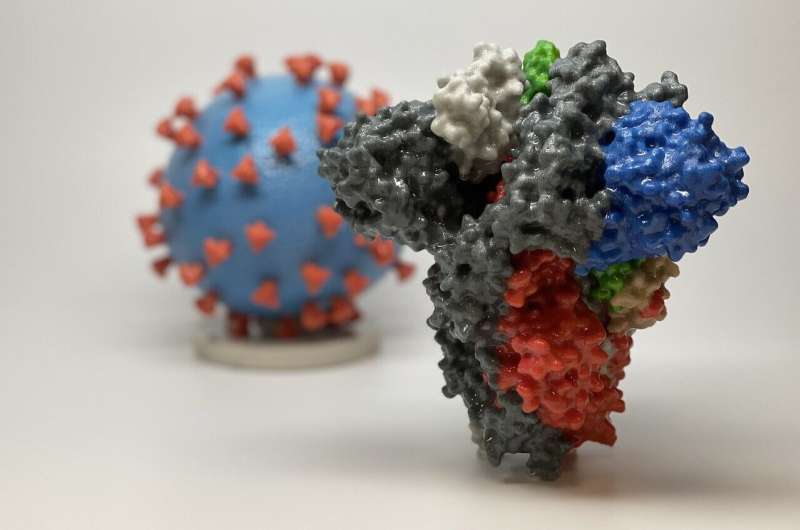3D print of a spike protein of SARS-CoV-2, the virus that causes COVID-19—in front of a 3D print of a SARS-CoV-2 virus particle. The spike protein (foreground) enables the virus to enter and infect human cells. On the virus model, the virus surface (blue) is covered with spike proteins (red) that enable the virus to enter and infect human cells. Credit: NIH
As if the COVID-19 pandemic isn't scary enough, the flu season is not far away. How severe will the flu season be as it converges with the COVID-19 outbreak? What can we do to prepare?
Dr. Benjamin Singer, a Northwestern Medicine pulmonologist who treats COVID-19 patients in the intensive care unit, outlines the best defense against influenza, which also may protect against coronavirus.
In an editorial that will be published May 29 in the journal Science Advances, Singer, an assistant professor of pulmonary and critical care and biochemistry and molecular genetics at Northwestern University Feinberg School of Medicine, examines the epidemiology and biology of SARS-CoV-2 and influenza to help inform preparation strategies for the upcoming flu season.
He outlines the following four factors that could determine the severity of the upcoming flu season:
1. Transmission: Social distancing policies designed to limit the spread of COVID-19 are also effective against the flu. If COVID-19 cases begin to spike in the fall of 2020, re-tightening social distancing measures could help mitigate early spread of the flu to flatten the curves for both viruses.
2. Vaccination: As we await vaccine trials for COVID-19, we should plan to increase rates of vaccination against the flu, particularly among older adults who are more susceptible to both the flu and COVID-19.
3. Co-infection: We need widespread availability of rapid diagnostics for COVID-19 and other respiratory pathogens because co-infection with another respiratory pathogen, including the flu, occurred in more than 20% of COVID-19-positive patients who presented with a respiratory viral syndrome early in the pandemic.
4. Disparities: The COVID-19 pandemic has highlighted unconscionable disparities among African Americans, Latinx and Native Americans so we must galvanize public health efforts aimed to limit viral spread, increase vaccination rates, deploy rapid diagnostics and expand other health care services for vulnerable populations, including communities of color, the poor and older adults.
The Centers for Disease Control and Prevention estimated that the 2019-2020 seasonal influenza epidemic resulted in tens of millions of cases and tens of thousands of deaths.
"Even in non-pandemic years, the flu and other causes of pneumonia represent the eighth-leading cause of death in the United States, and respiratory viruses are the most commonly identified pathogens among hospitalized patients with community-acquired pneumonia," Singer said.
More information: "COVID-19 and the next influenza season," Science Advances (2020). advances.sciencemag.org/lookup … .1126/sciadv.abd0086
Journal information: Science Advances
Provided by Northwestern University























